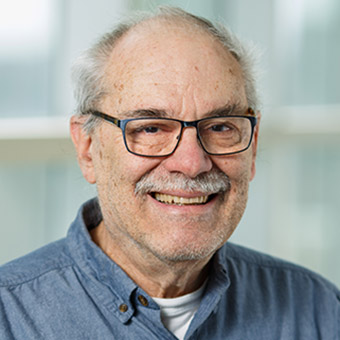Chris Miller
 Professor Emeritus of Biochemistry
Professor Emeritus of Biochemistry
Investigator, Howard Hughes Medical Institute
Member, US National Academy of Sciences
Research Description
Professor Miller has retired. His lab is closed.
Structure and Mechanism of Ion Channels and Transporters
Much of our work was aimed at understanding the molecular and structural underpinnings of the generation of cellular electricity. All such phenomena - from the nerve action potential, to sensory transduction, to control of processes as varied as muscle contraction, hormone secretion, or blood volume homeostasis - are ultimately mediated by a single class of membrane proteins: the ion channels. We sought to understand the molecular mechanisms by which ion channel proteins open and close to switch the flows of ions across cellular membranes, and by which the open pore is able to choose so exquisitely which ions are able to permeate. Cellular electrical behavior requires ion gradients across biological membranes, and these gradients must be established by energy-consuming "transporter" proteins, which move ions "uphill." Our group studied the mechanisms of transporters.
The lab focused on channels and transporters that are approachable by a combination of attacks in reduced, biochemically defined systems. We used a combination of electrophysiological analysis, single-channel recording, membrane biochemistry, and x-ray crystallography to attack these problems, and each student was expected to gain experience in all these methods. Efforts were directed at CLC Cl–-transporting proteins as well as a newly discovered subclass of these that specifically handle the cytotoxic F– ion. Our interest in F- exporting proteins led us to stumble upon a phylogenetically unrelated and very unusual class of F–-specific ion channel proteins.
We discovered, to our shock and awe, that a bacterial homologue of CLC channels is not itself an ion channel, but rather functions as an ion "pump," stoichiometrically exchanging Cl- on one side of the membrane for H+ on the other. Using a combination of electrophysiology, membrane reconstitution, and x-ray crystallography, we endeavored to understand how these transport proteins work and also to comprehend the wider mechanistic implications of this co-habitation within the same molecular family of such fundamentally different ion-transport mechanisms.
-
Turman, D.L., Cheloff, A.Z., Corrado, A.D., Nathanson, J.T., and Miller, C. (2018). Molecular interactions between a fluoride ion channel and synthetic protein blockers. Biochemistry 57:1212-1218. doi: 10.1021/acs.biochem.7b01272
-
Last, N.B., Stockbridge, R.B., Lajoie, A., Kolmakova-Partensky, L., Shane, T., Koide, A., Koide, S., and Miller, C. (2018). A CLC-type F-/H+ antiporter in ion-swapped conformations. Nature Struct. Mol. Biol.
-
Miller, C. (2018). Influences: Childhood, boyhood, and youth. J. Gen. Physiol. 150:649-651.
-
Tsai, C-W., Wu, Y., Williams, C., Phillips, C.B., Pao, P-C., Miller, C, and Tsai, M-F. (2017). "Proteolytic control of the mitochondrial calcium uniporter complex." Proc. Natl. Acad. Sci. USA 114: 4388-4393. doi:10.1073/pnas.1702938114
-
Last, N.B., Sun, S., Pham, M., and Miller, C. 2017. "Molecular determinants of permeation in a fluoride-specific ion channel." eLife2017;6:e31259.
-
Last, N. B., Kolmakova-Partensky L., Shane T. and Miller C. (2016). "Mechanistic signs of double-barreled structure in a fluoride ion channel."elife. 2016 Jul 23;5.
-
Miller, C. (2016). "Reductionism redux." eLife. 2016; 5: e16964.
-
Tsai MF, Phillips CB, Ranaghan M, Tsai CW, Wu Y, Willliams C, Miller C (2016). "Dual functions of a small regulatory subunit in the mitochondrial calcium uniporter complex." elife. 2016 Apr 21;5. pii: e15545. doi: 10.7554/eLife.15545.
-
Stockbridge RB, Kolmakova-Partensky L, Koide A, Koide S, Miller C, and Newstead S. (2015). "Crystal structures of a double-barreled fluoride ion channel." Nature. 2015 Sep 24;525(7570):548-51.